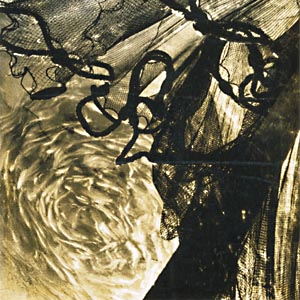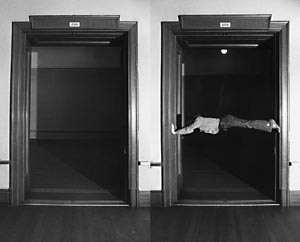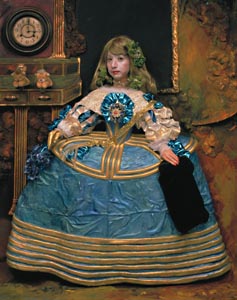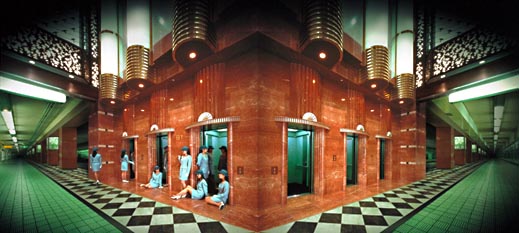 |
Focus features two in-depth reviews each month of fine art, architecture and design exhibitions and events at art museums, galleries and alternative spaces around Japan. The contributors are non-Japanese art critics living in Japan. |
|
|
 |
 |
 |
Developing Pictures
Matthew Larking |
 |
Progressive photography was underway in western Japan with the establishment of the amateur Naniwa Photography Club in 1904, though the Pictorialism the group initially endorsed through the 1920s goes without assessment in "Art of Photography / Photography as Art" at the Osaka City Museum of Modern Art. The majority of works shown date forward from the 1930s when the Tampei Photography Club joined the scene.
 |
 |
|
Bizan Ueda, Fishing (1930), 31.6 x 31.4 cm
|
|
Work like Ori Umesaka's "Snow on Paddy Fields" (1936) is merely the mechanical recording of visual experience; marginally more entertaining is the journalistic photography that sought out the "pregnant moments" that Henri Cartier-Bresson made his stock in trade, of which Takeji Iwamiya's "Naughty Boy" (1956/2007) is a fair example. Leaving aside such piquant instances, artful composition was the other early option, and Bizan Ueda's "Fishing" (1930), with its spatial divisions and varied textures and chiaroscuro effects, is at the more sophisticated end of works foregrounding the photographer's ability in formal selection and arrangement.
Avant-garde and creative proclivities were in evidence from the 1930s, particularly spurred by Kiyoshi Koishi's call for a sensibility that lay "on the far shores of realism." Surrealism, the Bauhaus' Laszlo Moholy-Nagi, and Man Ray were the crucial references for the New Photography, though some critics like the Photo Times' Shuzo Takiguchi argued for a conservative return to the documentary character of photography with the lens capturing surreal moments, rather than the manipulation of photographs to look like Surrealist paintings. An example of the latter is Gingo Hanawa's "Complex Imagination" (1936), which collaged semi-nude photography with miniature cogs, metal fittings and twisted wiring. Critic Tako Itagaki denounced the piece as being too indebted to the Dada of the late 1920s, though the piece today is given near canonical status in the history of Japanese photography.
Thematically, a recurrence throughout the 80-odd years the exhibition covers is an interest in the change of spatial location over the passage of time, as early pioneers Muybridge and Marey had drawn attention to. Ryuichi Amano's camera in 1930 captured the blurry stop-motion effect of trapeze artists at play, and Yoshihisa Kitasuji's "Work" (1973) in 24 pieces is a kind of cinematographic tracking shot, progressing forward at two-meter intervals. Hitoshi Nomura photographed "Dry Ice" (1969/2007) melting in stages with the times recorded, providing a process-oriented, pseudo-scientific documentary approach that expresses the relentless march of time, decay, and the precariousness of substance.
Gyoukai Sahoyama's "Daibutsuden Temple" (1950) has the quality of a film still, showing a dramatic view looking down from a tiled roof to three figures passing by. The piece seems to beg for a narrative, perhaps because the momentary slice-of-life-ness of the shot seems, if not in earlier periods, arguably more prodigious in our own time of video streams and expectations of filmic continuity. A final thread to the theme is added by Tokyo-born Hiroshi Sugimoto's theater series, as in "Marion Place, Ohio" (1980) where the photographer condenses the duration of an entire film into a single instance of luminosity.
 |
 |
|
Keiji Uematsu,Horizontal Position (1973),
two pieces, each print 145 x 90 cm
|
|
A handful of individual photographers warrant sustained attention. In "Horizontal Position" (1973) Keiji Uematsu created a kind of Vitruvian man somewhat different from Da Vinci's. A body is stretched out in the middle level of a doorframe open to a dark interior. The gist, arguably, is that the limit of perception terminates with the human subject, taken up in another work, "Seeing III" (1976). Here Uematsu plays with the habituation of geometric perspectival representation as a photographic and human commonplace relativized to local measures of the body, such as the distance between thumb and outstretched forefinger. The range gives both the length of a twig on the pavement nearby, and the span of a cruising riverboat at a distance.
 |
 |
|
Yasumasa Morimura, Daughter of Art History
(Princess B) (1990), 210 x 165 cm
|
|
In recent CG-enabled works, Yasumasa Morimura inserts his face and hands (typically the areas of painting done by the master in the workshop tradition) into canonical paintings from history, as in "Daughter of Art History (Princess B)" (1990). Morimura uses Western art history because of the impulse to fidelity of appearances which held sway for over 500 years and which became synonymous with the photographic medium, and therefore co-optative, in a way that Japanese art history could only lend itself to piecemeal.
Morimura produces a kitsch effect, situating himself in a line from Marcel Duchamp, who drew a moustache on a postcard of the Mona Lisa, down through the kitschification of Duchamp by Andy Warhol in mass media portraits, to the photographer himself, a recent iconoclast. The aesthetic is one of appearances easily falsified and bound to a certain staginess. Miwa Yanagi's "Elevator Girl House B1" (1997) rounds out the exhibition with the posed and physically pleasing elevator girls of Japanese department stores. Ostensibly a critique of enforced homogeneity and social expectations, the theme is, no doubt, as commercially pleasing to a generation versed in identity politics as the consumer goods retail giants dispense.
 |
|
Miwa Yanagi, Elevator Girl House B1 (1997), 180 x 400 cm
|
|
|
 |
 |
 |
Matthew Larking
Matthew Larking is an art historian based in Japan's old capital, Kyoto. He frequently writes art criticism concerning modernism and contemporary art in Japan and more broadly, Asia. His principal interests revolve around the development of modernism in the Asian context and its contemporary resonances.
|
|
 |
|